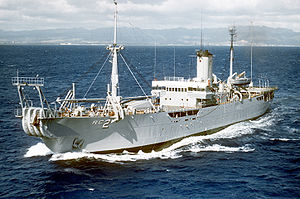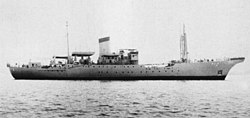
| |
| History | |
|---|---|
| Name |
|
| Builder | Pusey & Jones Corp., Wilmington, Delaware |
| Launched | 22 August 1945 |
| Commissioned | 1 June 1953 |
| Decommissioned | 1973 |
| In service | 1973 |
| Out of service | 1 January 1991 |
| Stricken | 20 August 1992 |
| Identification | IMO number: 8834897 |
| Motto | Find it, Fix it, Hide it. |
| Fate | Recycled in late 2005 |
| Notes | Ship underwent modifications as USS Neptune and a major modernization in 1982 with resulting changes in specifications. |
| General characteristics | |
| Type | S3-S2-BP1; Army cable ship, later USN Cable Repair Ship (ARC) |
| Displacement | 7,400 long tons (7,519 t) |
| Length | 362 ft 0 in (110.34 m) |
| Beam | 47 ft 0 in (14.33 m) |
| Draft | 25 ft (7.6 m) |
| Propulsion | 2 × Skinner Uniflow Reciprocating Steam Engines; changed to turbo-electric in 1982; twin shafts |
| Speed | 14 knots (26 km/h; 16 mph) |
| Complement |
|
| Armament | None |
USNS Neptune (ARC-2), was the lead ship in her class of cable repair ships in U.S. Naval service. The ship was built by Pusey & Jones Corp. of Wilmington, Delaware, Hull Number 1108, as the USACS William H. G. Bullard named for Rear Adm. William H. G. Bullard. She was the first of two Maritime Commission type S3-S2-BP1 ships built for the US Army Signal Corps near the end of World War II. The other ship was the Albert J. Myer, which later joined her sister ship in naval service as the USNS Albert J. Myer (T-ARC-6).
The ship was assigned to and largely worked on installation of the Sound Surveillance System (SOSUS) under its unclassified name for installation, Project Caesar.
Function



Neptune's assignments were typically to transport, deploy, retrieve and repair submarine cables, tow cable plow and acoustic projectors, and conduct acoustic, hydrographic, and bathymetric surveys. Civilian cable engineers and specialist were involved during cable or surveying operations in addition to a Navy crew of nine officers and 142 enlisted personnel. In addition to cable operations and surveys for Project Caesar the ship supported experimental efforts and other projects.
Career
After completion for the US Army Signal Corps in February 1946, Neptune was handed to the Maritime Commission and placed in the James River reserve fleet on 2 March 1946.
In 1952 Neptune was assigned to Project Caesar, the unclassified name for the installation phase of SOSUS. The system's mission was declassified in 1991. On 17 February 1953 the ship was named Neptune and withdrawn from the reserve fleet. The ship then went to the Bethlehem Steel Co. in Baltimore, Maryland for a number of modifications: e.g., electric cable machinery (in place of steam), precision navigation instrumentation, and a helicopter platform over the fantail. Cable drums 15 ft (4.6 m) in diameter and bow sheaves spanning 12 ft (3.7 m) were among the more visible modifications. On 1 June 1953 the ship was commissioned USS Neptune (ARC-2).
The ship's operations were classified so few specific ones are public. One was the 1962 connection of the array once terminating at Naval Facility Cape May to Naval Facility Lewes necessitated by destruction of the Cape May shore station in the "Ash Wednesday" Storm.
From December 1965 through March 1966 Neptune was overhauled in Boston. In 1973, Neptune transferred to the Military Sealift Command (MSC), was re-designated T-ARC-2, and continued operations with an MSC civil service crew.
Only two of the four cable ships available for Project Caesar had been designed and built as cable ships, the others being conversions and lacking some critical features needed for cable operations. The larger Aeolus and Thor were not suitable for modernization while Albert J. Myer and Neptune had cable ship features, including deeper draft than the larger ships, that made them suitable candidates for modernization. In hearings for the 1980 appropriations the Navy requested an increase of $9.6 million over an original estimate of $14.5 million in Neptune conversion budget for a total of $24.1 million. The revised estimate was based on actual Myer conversion costs. In particular the Navy was questioned about conversion of merchant type hulls to cable ships and answered that conversion would be more expensive. Further, charter of commercial cable ships was done when needed, but expensive and those ships were not always available when required. The AT&T CS Long Lines was used on occasion to lay trunk cable at a daily cost of $30,000 vice Neptune's $19,200. Scheduled Project Caesar work required a minimum of three Navy cable ships.
Neptune was extensively modernized in 1982 by General Dynamics Corporation in Quincy, Massachusetts. That work included new turbo-electric engines. Neptune and sister ship Albert J. Myer, with Skinner Uniflow Reciprocating Steam Engines, were the last ships in the Navy to operate using reciprocating steam engines.
Neptune performed cable repair duties all over the world until 1991, when she'd been in service for some 38 years. During her career, she received a Navy E ribbon in 1988.
Inactivated in 1991, the same year in which the SOSUS mission was declassified, she was placed in the James River reserve fleet near Ft. Eustis, VA on 24 September 1991. The ex-Neptune was removed from the fleet 6 December 1994 to stripped. The ship was dismantled and recycled by International Shipbreaking Ltd. of Brownsville, TX in late 2005.
Footnotes
- Large devices used to bury cable in coastal areas to protect from damage from trawls and other hazards.
- SOSUS and both operations and actual linkage of Project Caesar to SOSUS was at the time classified and tightly controlled. The system was covered as "oceanographic research" and the cable operations were not associated with undersea surveillance systems. Thus any public information, such as the referenced All Hands article, did not describe the true nature of the operations. The All Hands article "Underseas Cable Layer" emphasizes the cover story with the purpose being to connect remote ocean observation centers with shore stations.
- To preserve secrecy the shore terminals operated under the cover of "oceanographic research" and were designated by the generic term "Naval Facility" until most had been decommissioned in system consolidation and before declassification. See SOSUS.
- See photos before and after modernization.
References
- Shipbuilding History, Pusey & Jones, Wilmington DE Archived 2013-12-25 at the Wayback Machine
- shipbuildinghistory, S-Type Special-Purpose Ships
- ^ Cable Repair Ships. Navy Fact File (Report). Vol. 8. Washington, D.C.: Department of the Navy, Office of Information. 1987. p. IR-37. Retrieved 21 February 2020.
- "Underseas Cable Layer" (PDF). All Hands. No. 564. January 1964. Retrieved 21 February 2020.
- ^ Naval History And Heritage Command. "Neptune IV (ARC-2)". Dictionary of American Naval Fighting Ships. Naval History And Heritage Command. Retrieved 21 February 2020.
- ^ Maritime Administration. "Neptune (ARC-2)". Ship History Database Vessel Status Card. U.S. Department of Transportation, Maritime Administration. Retrieved 21 February 2020.
- Grover, David H. (1987). U.S. Army ships and watercraft of World War II. Annapolis, Md.: Naval Institute Press. p. 144. ISBN 0-87021-766-6.
- "USNS Neptune (T-ARC-2)". NavSource Online. Retrieved 28 September 2016.
- ^ "Integrated Undersea Surveillance System (IUSS) History 1950 - 2010". IUSS*CAESAR Alumni Association. Retrieved 1 February 2020.
- "Origins of SOSUS". Commander, Undersea Surveillance. Retrieved 13 March 2020.
- "The Navy at Cape Henlopen — Terminal Equipment Building". Retrieved 3 March 2020.
- Commander Undersea Surveillance. "Naval Facility Lewes, August 1955 - September 1981". U.S. Navy. Retrieved 11 February 2020.
- Committee on Armed Services (U.S. Senate) (1978). Department of Defense Authorization for Appropriations for Fiscal Year 1979. Washington, D.C.: Government Printing Office. pp. 4244–4246. Retrieved 3 March 2020.
- Subcommittee of the Committee on Appropriations (U.S. House) (1980). Department of Defense Authorizations for 1980. Washington, D.C.: Government Printing Office. pp. 638, 646, 660. Retrieved 3 March 2020.
 This article incorporates text from the public domain Dictionary of American Naval Fighting Ships. The entry can be found here.
This article incorporates text from the public domain Dictionary of American Naval Fighting Ships. The entry can be found here.- The Ships and Aircraft of the U.S. Fleet, Norman Polmar, Naval Institute Press, 13th edition, 1984.
- OPNAV NOTICE 1650, Master List of Unit Awards and Campaign Medals, 9 March 2001.
- MARAD press release 14-05, 28 July 2005, Maritime Administration announcement of the disposal of ex-Meyer & ex-Neptune.
External links
- Cable ship, William H. G. Bullard before launching
- Erecting bow sheave casting.
- Trial trip of the cable ship, William H. G. Bullard
- Photo gallery of Neptune at NavSource Naval History
- USS Neptune (ARC-2) / USNS Neptune (T-ARC-2)
- The USNS NEPTUNE - Cable Layer
| Neptune-class cable ships | |
|---|---|
| |
| World War II Maritime Commission ship designs | |
|---|---|
| Cargo designs | |
| Emergency cargo |
|
| Tanker |
|
| Special-purpose |
|
| Miscellaneous-cargo | |
| Tugs |
|
| See also:- Empire ship, Fort ship, Park ship, Ocean ship. | |
| United States naval ship classes of World War II | |
|---|---|
| Aircraft carriers | |
| Light aircraft carriers | |
| Escort carriers | |
| Battleships | |
| Large cruisers | |
| Heavy cruisers | |
| Light cruisers | |
| Gunboats | |
| Destroyers | |
| Destroyer escorts | |
| Patrol frigates | |
| Patrol boats | |
| Minelayers | |
| Minesweepers | |
| Submarines | |
| Tankers | |
| Cargo ships | |
| Auxiliary ships | |
| |